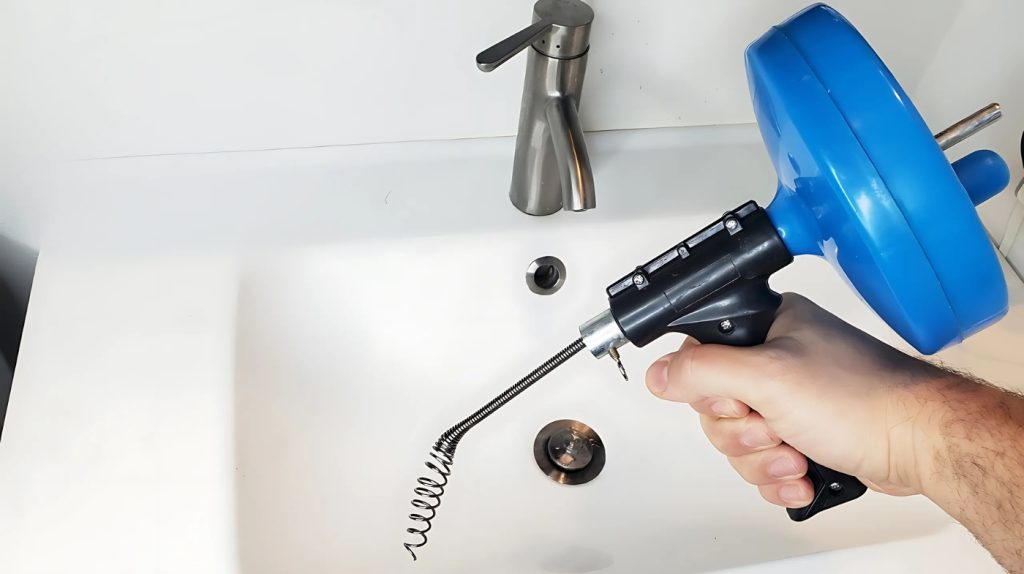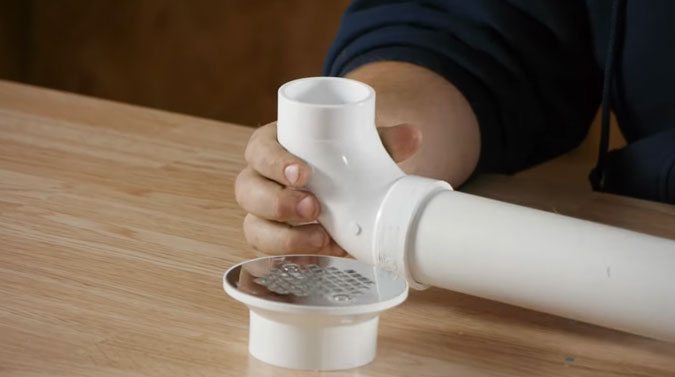Last Updated on March 13, 2025
If your auger isn’t clearing the clog, try a few alternative methods. Pour boiling water mixed with dish soap down the drain to tackle grease buildup.
Baking soda and vinegar can create a helpful reaction to dislodge debris. A plunger or a wire coat hanger might catch stubborn items.
If these methods still fail, it might be time to contemplate professional help. Keep going to explore more preventive measures and tools to keep your drains clear.
Key Takeaways
- Try using a plunger to create pressure that can dislodge the clog effectively.
- Use a drain snake to manually remove stubborn debris that the auger couldn’t reach.
- Pour a mixture of baking soda and vinegar down the drain to break down organic material.
- Boil water mixed with dish soap to help dissolve grease buildup in the pipes.
- If all else fails, consider calling a professional to assess potential systemic plumbing issues.
Common Causes of Clogged Drains
When you think about clogged drains, several common culprits likely come to mind. Hair and animal fur often become stuck, especially in bathroom drains. Soap scum builds up, creating stubborn blockages over time.
Toothpaste scum can also create sticky scum that clogs drains; this scum can trap hair and other debris, worsening clogs. Additionally, clogged impellers in plumbing systems can disrupt water flow, leading to more severe drainage issues.
In the kitchen, grease and fats coat pipe walls, leading to tough clogs. Large amounts of food waste, even with garbage disposals, can also cause issues. In bathrooms, toothpaste scum, makeup debris, and flushed items like cotton balls and feminine products can create severe clogs.
Outside, tree roots can invade pipes, while hard water contributes to mineral buildup. Regular maintenance and proper disposal can help you avoid these common problems and keep your drains flowing smoothly.
Natural Cleaning Methods to Try
Clogged drains can often feel intimidating, but natural cleaning methods offer effective solutions without harsh chemicals.
Start by pouring 1/2 cup of baking soda followed by 1/2 cup of vinegar into the drain. This combination creates a chemical reaction that can break down clogs. Baking soda and vinegar is particularly effective against hair, soap scum, and other debris.
Pouring 1/2 cup of baking soda followed by 1/2 cup of vinegar creates a powerful reaction to tackle drain clogs. Alternatively, mix 1/2 cup of baking soda with 1/2 cup of salt and pour it in to dislodge debris. For grease buildup, combine boiling water with dish soap and slowly pour it down the drain.
You can also try using Coca-Cola, as its carbonation and acidity help dissolve minor clogs. Finally, a wire coat hanger can manually remove visible debris. Always flush with boiling water afterward to clear any loose particles.
Mechanical Tools and Alternatives
When it comes to unclogging drains, mechanical tools can be your best friends. You can start with a plunger for quick pressure or use a wire hanger for snagging stubborn debris.
If those don’t work, exploring drain snake options might just give you the extra help you need to clear the blockage. Drain snakes are particularly effective against hair and physical clogs that other methods may struggle to address.
Additionally, using a lightweight tool like a drain snake can simplify the process of tackling minor clogs without the need for professional assistance.
Plunger Techniques Explained
Using a plunger effectively can make all the difference in tackling a stubborn drain clog. First, choose the right plunger that fits your drain size for ideal results. Selecting the appropriate type can enhance clog removal and ensure you have the best chance of success.
Verify the water level covers the plunger cup to create a good seal. It’s also smart to plug nearby drains to maximize pressure on the clog. For a tighter seal, apply petroleum jelly around the plunger rim.
When you start plunging, use firm, consistent up-and-down motions for about 30 seconds. This technique helps dislodge stubborn debris. If plunging doesn’t work, consider using a drain snake or a wet-dry vacuum as alternatives. Remember, regular maintenance can prevent future clogs, saving you time and frustration.
Wire Hanger Solution
Transform a simple wire hanger into an effective tool for unclogging drains. Here’s how to prepare and use it:
- Modification: Straighten the hanger completely, then bend one end to create a hook. Use pliers to shape a handle on the other end.
- Insertion: Remove the drain cover or stopper, then insert the hook end into the drain. A household wire hanger is required for this method.
- Operation: Twist the wire clockwise to engage the clog, then pull it out slowly. Repeat as needed until the clog is cleared.
Always be cautious to avoid scratching the drain pipes. This wire hanger method is a handy alternative when other tools fail, and it’s easy to do with items you already have at home.
Drain Snake Options
A variety of drain snake options are available to help you tackle stubborn clogs effectively. A standard drain snake or auger is great for physically removing clogs, while a toilet auger specializes in clearing blockages without damaging porcelain.
For deeper clogs, consider an extra-long drain auger or a small drum auger for kitchen and bathroom sinks. If you encounter severe clogs, a power auger can provide the extra force needed. Don’t forget about alternatives like plungers, which create suction, or a DIY cable tool made from bent wires.
Natural methods, such as baking soda and vinegar or dish soap with hot water, can also help break down blockages without harsh chemicals. Using a plunger can be a common method for unclogging drains when other options fail.
Effective Use of a Plunger
Plunging a clogged drain can be a quick and effective solution if done correctly. To guarantee success, follow these steps:
- Choose the Right Plunger: Use a sink plunger for sinks and bathtubs, and a toilet plunger with a flange for toilets.
- Prepare the Drain: Make certain there’s enough water to cover the plunger cup, remove visible debris, and block any overflow openings with a wet rag.
- Plunge Effectively: Start with a gentle push to create a seal, then use fast, forceful strokes. Push down slowly and pull up quickly to create suction. Remember that effective plunging relies on understanding the pressure changes created by the tool.
Identifying Common Clog Locations
When tackling a clogged drain, it’s important to know where clogs commonly occur. Identifying these locations can save you time and effort.
Here’s a quick reference:
| Location | Common Causes | Symptoms |
|---|---|---|
| Toilets | Excess toilet paper, biological matter | Gurgling sounds |
| Kitchen Sinks | Grease, food particles | Slow drainage |
| Shower Drains | Hair, soap scum | Standing water |
| Bathroom Sinks | Hair, makeup products | Frequent backups |
| Sewer Lines | Tree roots, inappropriate items | Backups in multiple fixtures |
Additionally, frequent unexplained toilet clogs may signal a bigger problem that needs to be addressed.
When to Call a Professional Plumber
Recognizing the signs of a serious clog is essential for maintaining your plumbing system. If you encounter any of the following, it’s time to call a professional plumber:
- DIY Methods Fail: If your plungers and augers aren’t working, the issue might be more severe than you think, potentially indicating a damaged check valve that needs attention.
- Sewage Backup: If sewage is backing up into your home, this urgent situation requires immediate professional attention.
- Multiple Clogged Drains: When several drains are clogged simultaneously, it usually indicates a systemic plumbing issue that needs expert diagnosis. Additionally, multiple clogged drains may suggest a problem with the entire plumbing system, further emphasizing the need for professional help.
Ignoring these signs can lead to increased damage, health risks, and higher repair costs. Don’t hesitate, address serious clogs promptly to protect your home and plumbing system.
Preventive Measures for Future Clogs
To keep your drains flowing freely, it’s crucial to adopt preventive measures that can greatly reduce the risk of future clogs.
Start by using mesh drain strainers in sinks and showers to catch hair and food scraps. Make sure these strainers fit snugly and clean them regularly to maintain their effectiveness.
Additionally, using a mesh drain strainer is an inexpensive and widely available tool that can prevent non-liquids from flowing down the drain. Regularly cleaning your strainers can help avoid clogging issues that could lead to more serious plumbing problems.
Dispose of grease properly, never pour it down the drain—and run cold water with your garbage disposal to flush food particles effectively. Educate your household about what can and can’t be flushed, and avoid flushing non-disintegrating items.
Finally, run hot water through your drains regularly and consider using natural cleaners like baking soda and vinegar for maintenance. These simple steps can save you time and trouble down the line.
Frequently Asked Questions
What Are the Signs of a Severe Clog?
When you’re dealing with a severe clog, watch for multiple drains backing up, unusual sewage odors, and gurgling noises from your plumbing.
You might notice slow drainage in sinks, tubs, or toilets, and visible backflow of wastewater. These signs indicate a significant blockage that needs attention.
Flushing non-biodegradable items or grease can cause these issues, so be mindful of what goes down your drains to prevent further problems.
Can Chemical Cleaners Be Harmful to Pipes?
Chemical cleaners can seem like a quick fix, but they might actually harm your pipes in the long run. While they dissolve clogs effectively, their corrosive nature can weaken PVC and metal pipes, leading to leaks and costly repairs.
You’ve got safer alternatives, like baking soda and vinegar, that won’t damage your plumbing.
How Often Should I Clean My Drains?
You should clean your drains regularly to prevent clogs. For kitchen drains, aim for every 4-6 months, while bathroom drains need attention every 3-4 months.
Toilets benefit from professional cleaning every 6 months, especially with heavy use. If you’re in a commercial setting, monthly or quarterly cleanings are best.
Consider your drain’s usage and age, as these factors can influence how often you need to clean them for peak performance.
Are There Home Remedies for Persistent Clogs?
Got a stubborn clog? You’re not alone! Home remedies can be lifesavers. Try pouring a mix of baking soda and vinegar down the drain; the fizzing reaction helps break down buildup.
Boiling water can dissolve grease, while a wire hanger can fish out hair. For an extra boost, combine salt and baking soda. Regular use of these remedies keeps your drains flowing smoothly and saves you from future headaches!
What Tools Do I Need for Drain Maintenance?
For effective drain maintenance, you’ll need a few essential tools. Start with a plunger to tackle minor clogs. A drain snake can help with deeper blockages, while a hydro-jetter is great for stubborn issues.
Don’t forget an inspection camera to diagnose problems, and consider chemical cleaners for occasional use. Regularly using baking soda and vinegar can also keep your drains clear. These tools will help you maintain a healthy plumbing system.
Plungers & DIY Fixes: Your Backup Crew for Stubborn Clogs
In the journey of home maintenance, unclogging a drain can feel like maneuvering a stormy sea. When the auger fails, remember you’ve got other tools and methods at your disposal—like the trusty plunger or natural remedies.
By understanding common clog locations and taking preventive measures, you can steer clear of future troubles. If the waters get too rough, don’t hesitate to call a professional.
With a little persistence, you’ll keep your plumbing shipshape and sailing smoothly.


